AP SSC 10th class General Science 2 Model paper 2015-16 English Medium Set 4
SECTION-I
1.What happens when stomata are closed with nail polish ?
2.Why does a deep sea diver carry oxygen cylinder on his back ?
3.What are the three types of blood vessels in the body ?
4.What is latex ? What is it’s economic importance ?
5.
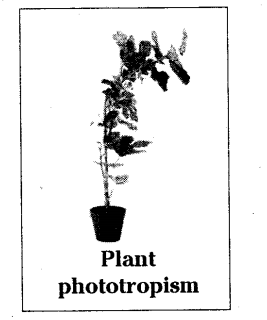
Write the reason for the bending of the potted plant towards one side.
6. What are the results of deforestation ?
SECTION-II
Group – A
7. Write the differences between inspiration – expiration.
8.Write the symptoms of Kwashiorkor.
9.What is the significance of Lymph in man ?
10.Write two uses of Resins and Tannins
Group -B
11.What is a synapse ? How is it useful in transfer of information ?
12.How sex determination takes place in human beings ? Explain.
13.Mention the different birth control methods with examples.
14.What suggestions do you give to reduce migration of rural population ?
SECTION-III
Group-A
15

You have done this experiment at your science laboratory. Now answer the following questions
a)What is the aim of the above experiment ?
b)What is the purpose of black paper in the above experiment ?
c)What is the chemical that is used to identify the presence of starch ?
d)How do you destarch the plant before conducting the photosynthetic experiments ? Vicky
16.wants to grow a single plant having two desirable characters colourful flowers and big fruits. What method will you suggest him and why ?
17.Give reasons for the following.
a)Why pyramids of biomass of terrestrial ecosystems are always upright ?
b)Why do we salivate during a nap of day time ?
c)We can’t identify taste when food is very hot.
d)The carbohydrates are not digested in the stomach.
18.What procedure do you follow to prove that C02 is released during aerobic respiration ?
Group – B
19.Prepare a model for rain water harvesting that reflect your innovative thoughts.
20.Prepare a suggestive action plan for controlling harmful affects of human activities.
21.Explain Darwin’s theory of evolution, “natural selection” with an example.
22.With the help of a diagram show the movement of food from mouth to the stomach. What muscles and nerves are involved in the movement of food and what is this action called ?
SECTION-IV
23.Draw a neatly labelled diagram of female reproductory system of human beings.
24.Draw a neatly labelled diagram of ’human brain’.
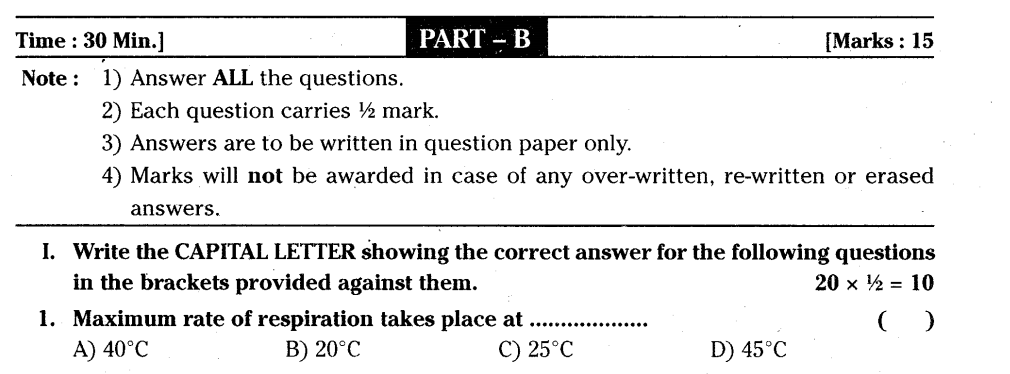


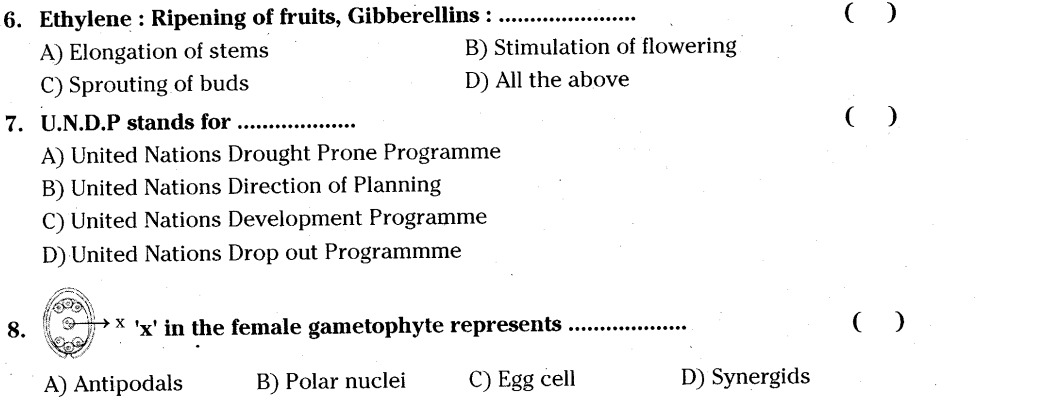
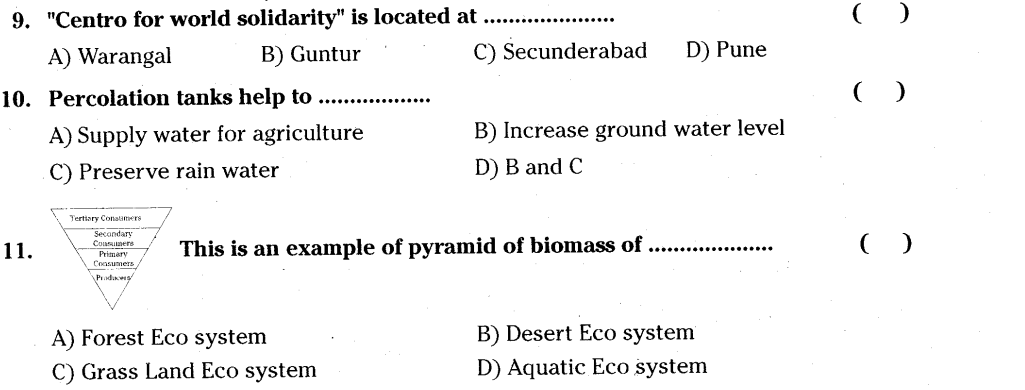
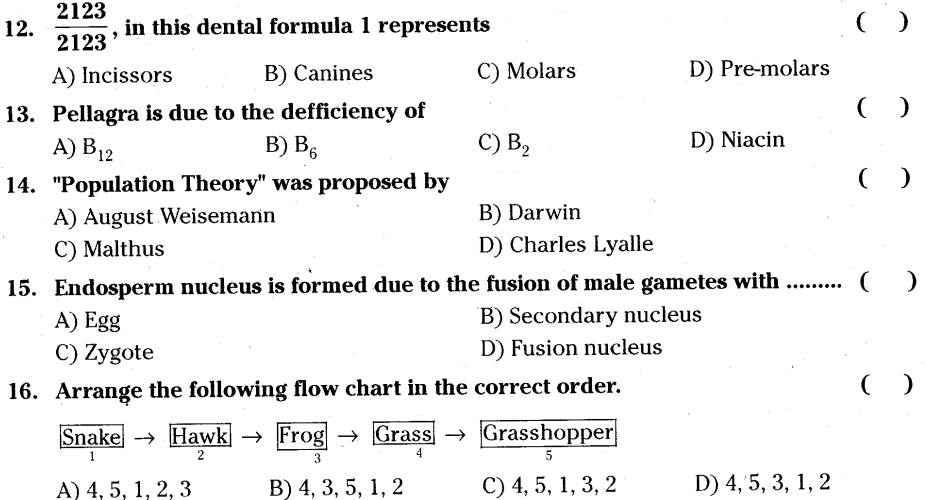
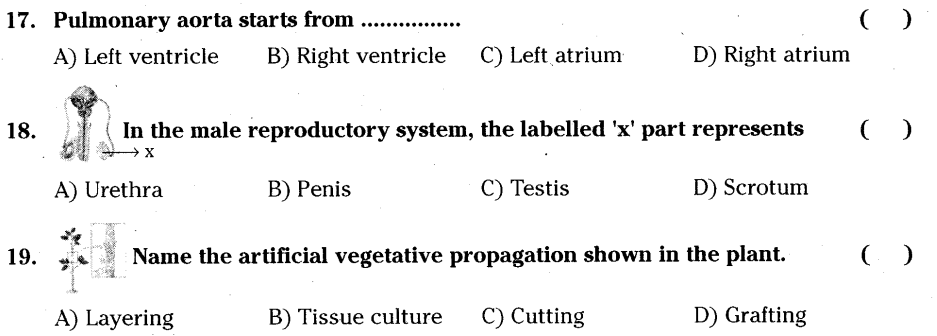


Answers
SECTION-I
1.What happens when stomata are closed with nail polish ?
Ans.a) Gaseous exchange and preventing water loss from the plants are the main function of stomata. .
b)If the stomata are closed, there would be no possibility of gaseous exchange. Hence, there will be no photosynthesis and respiration.
2.Why does a deep sea diver carry oxygen cylinder on his back ?
Ans.1) Oxygen is present in dissolved state in water.
2)Human beings do not have gills like the fish which can extract dissolved oxygen from water and utilise it for breathing.
3)Moreover as we go deep down in water, the oxygen level starts decreasing.
4)So a deep sea diver carries an oxygen gas cylinder for breathing when he goes deep under’the sea water.
3.What are the three types of blood vessels in the body ?
Ans.The three main types of blood vessels in the human body are :
1)Arteries, 2) Veins and 3) Capillaries.
4.What is latex ? What is it’s economic importance ?
Ans.i) Latex is a sticky, milky white substance secreted by plants.
ii)It is stored in latex cells or latex vessels.
iii)Rubber is obtained from the latex of “Hevea Braziliences”.
iv)Latex from “Jatropa” is the source of bio-diesel.
5.Write the reason for the bending of the potted plant towards one side.

Ans.Because of phototropism, the plant turned towards the light.
6.What are the results of deforestation ?
Ans.i) Deforestation destroys wildlife habitats and increases soil pollution.
ii)Deforestation increases green house gases into atmosphere contributing to “Global warming”.
SECTION-II
Group – A
7. Write the differences between inspiration – expiration.
Ans.

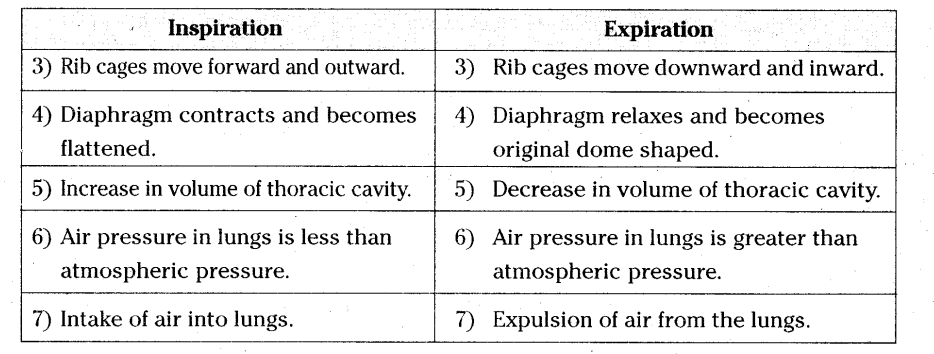
8.Write the symptoms of Kwashiorkor.
Ans.1) Body parts becomes swollen due to accumulation of water in the intercellular spaces.
2)Very poor muscle development, swollen legs, fluffy face, difficult to eat, diarrhoea, dry skin are the symptoms of Kwashiorkor disease.
3)The child becomes lethargic and shows little interest in its surroundings or in playing and learning.
9.What is the significance of Lymph in man ?
Ans.Lymph is a circulatory fluid. It flows in lymph vessels.
1)Lymph (is also called tissue fluid) is colourless.
2)It consists of lymphocytes which kill germs and protect the human body from infections.
3)Lymph carries digested and absorbed fat from intestine.
4)It drains excess fluid from extra cellular space back into the blood.
5)Its flow is unidirectional i.e., from tissues lymph capillaries -> vein heart.
10.Write two uses of Resins and Tannins.
Ans.i) Resins are present in Gymnosperms, in a specialised passages called Resin passages, e.g.: Pinus
ii)They are used in Resins.
iii)Tannins are used in tanning of leather and in medicines, eg.: Cassia, Acacia
Group – B
11.What is a synapse ? How is it useful in transfer of information ?
Ans.Dendrites of one nerve cell connect to the other or to the axons of the other nerve cell through connections is called as a synapse.Synapse is a functional region between two neurons, where information from one neuron is transmitted or relayed to another neuron.Though these regions are of minute gaps and they do not have any protoplasmicconnections between them yet information is passed from one nerve cell to the otherthrough these gaps either in the form of chemical or electrical signals or both.These synapses are mainly found on the brain, spinal cord and around the spinal cord.
12.How sex determination takes place in human beings ? Explain.
Ans.1) Sex determination of the baby depends on the sex chromosome carried by the sperm, as the ovum always carries X chromosome only.
2)If the sperm with X chromosome fuses with ovum, the baby will have XX condition. So the baby will be a girl.
3)If the sperm with Y chromosome fuses with ovum, the baby will have XY condition.So the baby will be a boy. ,
4)So the sperms that come from father decides the sex of the baby.
5)In fact it is by mere chance and the chance for any sex formation is 50% as the male produces both sperms with X and sperms with Y are produced in same number.
13.Mention the different birth control methods with examples.
Ans.1) The prevention of pregnancy in women by preventing fertilisation is called contraception.
2)Any device or chemical (drug) which prevents pregnancy in woman is called contraceptive.
3)Physical devices such as condoms and diaphragm (cap) are used. This prevents reaching of sperms to ova for fertilisation.
4)Chemicals in the form of pills are induced either orally or inserting into female reproductive organ vagina.
5)Pills for males kill the sperms and hence are called spermicide.
6)The use of intra – uterine device called copper – T, loop, etc., are also very effective in preventing pregnancy.
7)Surgical methods of birth control are available for males as well as females.
8)In males a small portion of vas deferens (sperm duct) is removed by surgical operation and both ends are tied properly. This method is called Vasectomy.
9)In females a small portion of oviducts (fallopian tubes) is removed by surgical operation and the cut ends are tied. This method is called Tubectomy.
14.What suggestions do you give to reduce migration of rural population ?
Ans.1) Agriculture associated industries should be established in rural areas.
2)Providing modern equipments to handicraft workers.
3)There should be proper connectivity to cities to sell their products.
4)There should be facilities for maintainance of equipment and their repairs.
SECTION-III
Group-A
15.a)What is the aim of the above experiment ?
Ans.To prove that light is necessary for photosynthesis.
b)What is the purpose of black paper in the above experiment ?
Ans.To cover the leaf in order to prevent the exposure of that particular part of the leaf to the sunlight.
c)What is the chemical that is used to identify the presence of starch ?
Ans.Iodine Test
d)How do you destarch the plant before conducting the photosynthetic experiments ?
Ans. By keeping the potted plant in a dark room for 3 – 4 days, till all the starch present in the leaves is exhausted
16.Vicky wants to grow a single plant having two desirable characters colourful flowers and big fruits. What method will you suggest him and why ?
Ans.Aim : To observe the different stages of mitosis in onion root tip.
Apparatus : Slide, microscope, cover slip, dilute HC1, spirit lamp, glass rod, needle, brush, fresh onion roots.
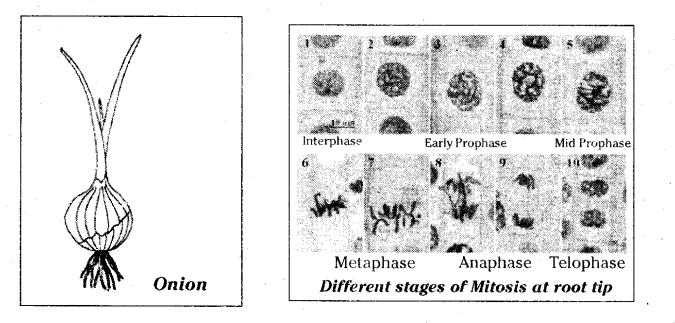
Procedure:
i)Collect freshly grown onion root tips cut off the last 5mm of it and place them in a test tube.
ii)Add dil. HC/ and heat it on spirit lamp for 5 min. to soften the root tissue.
iii)Decant the liquid carefully, wash the root tip on a watch glass containing water to remove acid.
iv)Remove the excess water with help of filter paper.
v)Place the tip on the slide and add one drop of methylene blue.
vi)Now gently tap the root with end of the glass rod until it is completely broken
vii)Place a cover slip on tip and warm gently for a few seconds over very low flame. Take care that it must not boil.
viii)Put a piece of filter paper over the preparation and press the cover slip with your thumb avoiding any side way movements.
ix)Observe under microscope and draw what you have observed, in your notebook.
17.a) Why pyramids of biomass of terreastrial ecosystems are always upright ?
Ans.1) In a terrestrial ecosystem, the biomass progressively decreases from producers to top carnivores.
2) In the same way, the number of individuals at each tropic level decrease from producers to consumers. Hence, these pyramids are upright.
b)Why do we salivate during a hap of day time ?
Ans.1) Nocturnal animals are active during nights but we are active during daytime and take rest at night.
2)All the systems of our body are active in function during the daytime of our activity. Hence, man is a diurnal animal.
3)Our digestive system is also active and ready to receive the food for digestion.
4)If we sleep during daytime saliva oozes out of our mouth and wets the pillows.
5)This will not happen during night time.
c)We can’t identify taste when food is very hot.
Ans.Reason :
1)Most of the taste buds on the tongue are killed when the food is hot.
2)This prevents the person identifying the taste.
3)The perception of taste decreases when the temperature of the food rises beyond 35°C.
4)But we don’t pay attention to it because we become worried about the burning feeling.
d)The carbohydrates are not digested in the stomach.
Ans.i) The enzymes which acts upon carbohydrates are active in alkaline medium only.
ii) Due to the presence of acidic medium, amylase become inactive. Hence, there is no digestion of carbohydrates takes place in stomach.
18.What procedure do you follow to prove that C02 is released during aerobic respiration ?
Ans.1) Heat the glucose solution in a beaker, pour it in a thermos flask.
2) To remove dissolved oxygen from glucose solution by boiling it in thermos flask for a minute and then cooling it without shaking.
3)Now add some yeast to the glucose solution and fix two-holed rubber stopper to the flask.
4)The supply of oxygen from the air can be cut off by pouring a 1cm layer of liquid paraffin on the mixture (Thermos is heat resistant can’t be used for boiling).
5)Insert one end of the thermometer into the thermos flask. See the end of thermometer kept inside the solution.
6)Arrange for any gas produced by the yeast to escape through a wash bottle containing • bicarbonate solution or lime water as shown in the figure.
7)Add a few drops of diazine green (Janus Green B) solution to the yeast suspension before you pour liquid paraffin over it.
8)The blue diazine green solution turns pink when oxygen is in short supply around it.
9)Warm the apparatus to about 37° F in order to speed up the test. (If you do experi- . ment in test tube).
10)Keep the apparatus undisturbed for one or two days.
Group -B
19.Prepare a model for rain water harvesting that reflect your innovative thoughts.
Ans.
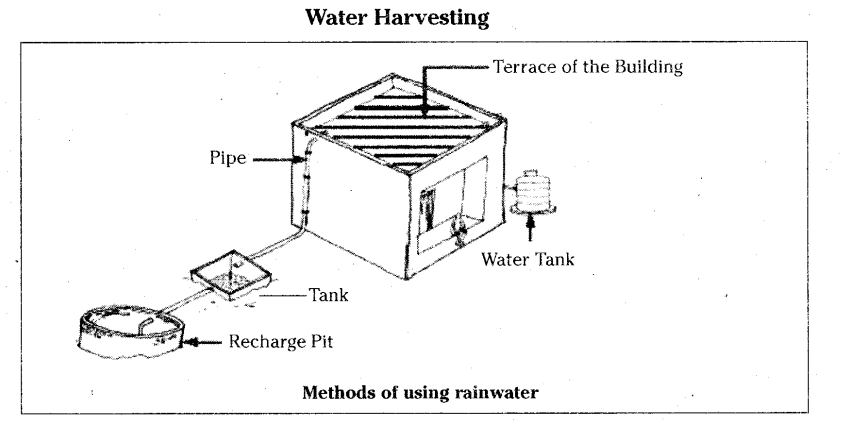
Procedure to prepare a model for rain water harvesting :
1)Make a model of a house with roof little slanting towards one side.
2)Connect a tube/pipe to the down end such that the rain water that falls on roof can be collected.
3)Connect the other end of this tube to a barrel like structure which can be used as storage tank.
4)From the tank arrange a tube towards the garden along with a valve that can be closed and opened.
5)Arrange one more tube with valve into a recharge pit or percolation pit arranged at one corner.
6)Arrange a tap to the tank that can be opened to collect the water for cleaning floor, vehicles, etc.
7)During rain, water from roof can be collected into tank and we can utilize it later for gardening or cleaning purposes.
8)When water is in excess it can be used to recharge underground water.
20.Prepare a suggestive action plan for controlling harmful affects of human activities.
Ans.The following steps should be taken to reduce the harmful effects of human activities.
a)Tall chymneys and ESP [electro static Precipitators] are installed in the factories to reduce the air pollution at the ground level.
b)Better designed fuel burning equipment should be used in homes and industries in order to reduce the air pollution.
c)Usage of CNG in motor vehicles should made compulsory.
d)Renewable alternative energy resources like solar energy, wind energy and hydral power are developed in a large scale.
e)Indiscriminate usage of pesticides and fertilizers should be avoided.
f)People should follow Rs. 3 principles i.e., Reduce, Reuse and Recycle, the waste products so that we can reduce the soil pollution.
g)Biological controling of pests, crop rotation and development of genetic resistant strains are the solutions for the control of pesticide pollution.
h)Reforestation using bio-fertilizers and safe disposal of solid wastes are the best methods to reduce the pollution.
21.Explain Darwin’s theory of evolution, “natural selection” with an
Ans.Darwin’s theory of evolution in a nutshell:
1)The theory of natural selection was proposed by Charles Darwin.
2)This theory states that nature only selects or decides which organism should survive or perish in nature.
3)The organisms with useful traits will survive.
4)The organisms having harmful traits are going to be perished or eliminated from its environment.
For example we have seen in the case of red beetles which were seen and eaten by crows. So, the population of red beetles gradually got eliminated or perished from its environment. But at the same time the beetles which are green in colour which are present on the green leaves were not noticed by crows. So the green beetles survived in the environment and their population have gradually increased. This is nothing but “natural selection”.
22.With the help of a diagram show the movement of food from mouth to the stomach. What muscles and nerves are involved in the movement of food and what is this action called ?
Ans.Muscles involved in movement of food from mouth to stomach :
1) Typical movement of the oesophagus, stomach and intestine is called peristalsis. The muscles of the mouth enable the food to be pushed in the oral cavity.
2)The first major muscle movement occurs when food or liquid is swallowed. Once the swallowing begins, it becomes involuntary and proceeds under the control of nerves in the jaw.
3)Contraction and relaxation of circular and longitudinal muscles in the oesophagus bring in a wave-like motion that propels the bolus into stomach by the action called peristalsis.
4)As the food approaches the closed ring of pyloric sphincter the surrounding muscles relax and allow the food to pass.
5)The muscles of the upper part of the stomach have to relax and accept large volumes of swallowed material.
6)The lower part of the stomach mixes food, liquid and digestive juice by its muscle action.
Nerves involved in the movement of food :
1)The fifth cranial nerve has been found to control the movement of muscles in the jaw.
2)Under the action of autonomous nervous system saliva is secreted to make chewing and swallowing easier.
3)Peristalsis in oesophagus is also under the control of autonomous nervous system.
4)When the food is in the oral cavity, the nerves in the cheek and tongue are stimulated and carry messages in the form of nerve impulses to the brain.
5)These messages are transmitted from the brain to the wall of the stomach and stimulate the gastric glands to produce gastric juice.
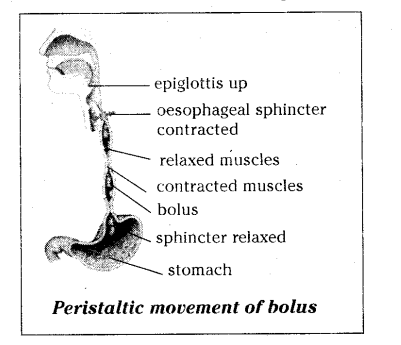
SECTION-IV
23.Draw a neatly labelled diagram of female reproductory system of human beings.
Ans.
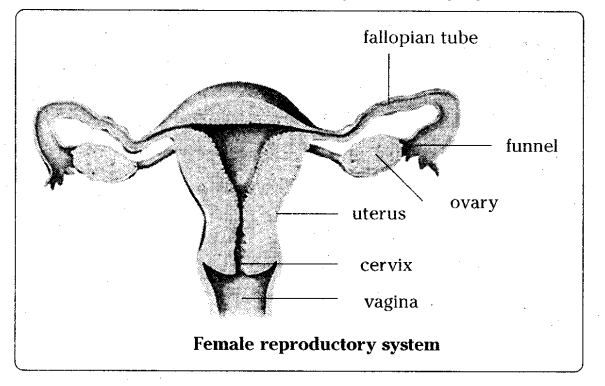
24.Draw a neatly labelled diagram of ‘human brain’.
Ans.











(Download Questions PDF)
(Download Solutions PDF)
<!–
–>